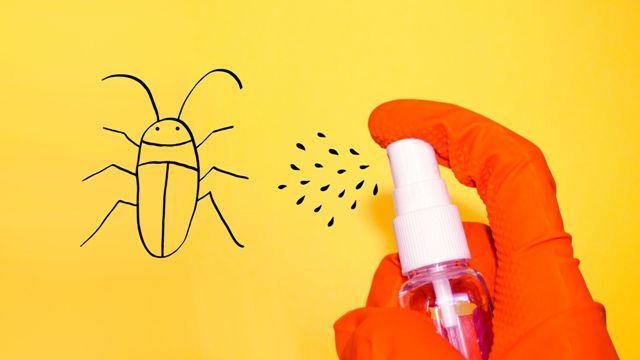
10 Effective DIY Insect Repellents for Home and Garden
Naturally YoursShare

Are you troubled by the annoying insects and pests that invade our homes, damage furniture and kill our dear little gardens?
Getting rid of those pesky creatures is a bugging job and a double-edged sword.
Often, the remedies including professional pest control can cause problems like allergies and irritations.
Some of the chemicals used in the bug sprays and other insect repellents are extremely dangerous to human beings and pets as they may cause serious health problems in the long run.
I, for one, have always been troubled by using cockroach repellent sprays inside the house. Apart from possible side effects, some sprays cause discoloration on the ceramic surfaces which turns into dirty stains overtime.
If you are facing similar issues, try the following 10 simple alternatives that you can do own your own.
These methods are effective and relatively harmless as most of them use herbal ingredients. As there are no strong chemicals used, one has to be patient and consistent with these recipes to get desired ‘exterminating’ results.
Insect Repellent for Home
1. Camphor solution for lizards:
Lizards are generally harmless reptiles and they help us by feeding on mosquitoes and other insects.
But if you find them gross and creepy, there is a gentle way to get rid of them.
- Lizards are repelled by the odor of camphor.
- Dissolve enough camphor in water to make a strong concentrate.
- Use this solution regularly to spray on corners, behind the wall shelves and wall clocks and on every area where they usually hide.
- After few days you will notice that there are no more lizards in your home.
2. Sugar Ball trap for cockroaches
Roaches are one species with high survival abilities. They are passive carriers of pathogens like bacteria and virus. They can also cause allergies in humans.
Borax (sodium borate) is very effective cockroach deterrent.
- To make the trap, mix equal parts of plain flour (preferably rice flour or wheat flour) and sugar.
- Add two parts of borax powder into the mixture.
- Add enough water to get a dough-like consistency.
- Make small balls of the mixture and place in corners and other areas where cockroaches are usually found.
- The sugar and flour will attract the insects.
- Once cockroaches ingest the chemical, it penetrates their exoskeleton and kills them by dehydrating.
Note: Borax is very cheap and is easily available in online stores. It is a low-risk pesticide and will cause irritation only if used in large quantities.
Still, it is advisable to use the next recipe if you have kids or pets at home. Also, remember to use plastic gloves while making borax balls.
We can easily make a cockroach spray at home using tea tree oil, vinegar and water.
- Pour 1 part (about ¼ cup) each of tea tree oil and vinegar into a spray bottle.
- Add 2 parts (8 cups of water) in to the bottle.
- Give it a good shake and cockroach spray is ready to use.
- Essential oil of dill is another natural cockroach repellent.
3. Neem potpourri against silver fishes
Are those tiny silver fishes eating your precious books and ruining your clothes?
Worry not. You can easily take care of the problem using neem leaves. Neem has very high antifungal and anti-pesticidal properties.
Place a fresh, washed neem sprig each, between the front and back cover of every book in your shelf.
For your wardrobe, sprinkle a few drops of neem oil and neem extract on dry neem leaves and put them in small mesh/sheer bags.
Leave these bags inside your shelves with the mouth of the bags slightly opened for the smell to waft through the cupboard.
This will keep the silverfishes away. Keep sprinkling the neem oil/ extract on the leaves once in a week.
Replace the ‘potpourri’ when the leaves start to wither.
4. All- purpose bug repellent
- Add 3-4 tbsp of dried herbs like peppermint, spearmint, lavender, eucalyptus, catnip etc. along with 2-4 dried cloves into 1 cup of water.
- Heat the mixture and bring to a boil.
- Cool and strain the liquid.
- Add 1 cup of witch hazel into the solution.
- All- purpose bug repellent is ready to use. You can pour it into a spray bottle for easy use.
- You can substitute witch hazel with rubbing alcohol. This solution effectively drives away ants.
Warning: Rubbing alcohol is highly inflammable. Never use it near open flame or high heat.
5. Diatomaceous Earth (DE): The ‘Super Terminator’ of Bugs
Diatomaceous Earth is a naturally occurring mineral, that is made up of fossiled remains of tiny aquatic organisms called ‘diatoms’.
It exists in sedimentary rock form and can be crumbled into fine powder. DE is widely popular in pest-control due to its effectiveness.
Though not a poison, it kills a wide range of pests and insects like, bedbugs, dust mites, ants, fleas, carpet beetles and cockroaches.
It pierces the exoskeleton of insects and causes them to dry out and die. Since it is not a chemical pesticide, the bugs won’t develop resistance against DE.
You can merely sprinkle some DE on the carpet, beddings, furniture upholstery or anywhere you think the bugs reside and watch them perish.
Food-grade diatomaceous earth is considered safe for humans. It is inexpensive and widely available in online stores.
Note : Use only food-grade diatomaceous earth for your DIY recipes. DE is an effective pesticide for your garden too.
6. Rub-on mosquito repellent
- Add any one of eucalyptus oil, peppermint oil, citronella oil, lemongrass oil or rosemary oil to of any carrier oil (coconut oil, jojoba oil, olive oil etc.) in the ratio1:9.
- Mix well.
- The aromatic mosquito repellent oil is good to go.
Pesticides for Garden

7. Rice water and onion skin spray for leaf roller bugs
- Take 1 litre of boiled rice water and add a good amount of onion skin into it.
- Keep this solution in a closed vessel for 3 days for fermenting.
- Sprinkle this mixture on plants to keep the leaf rollers(leaf folders) and white molds away.
8. Hydrogen peroxide spray for fungi
Hydrogen peroxide acts as a pesticide as well as a fungicide. It also gives an oxygen boost to the plant.
- Mix ½ cup of hydrogen peroxide with 3.5 litres of water.
- Keep the solution in air-tight bottles, away from sunlight for later use.
- Spray the mixture to foliage and roots to cure fungal infections and root rot.
- This method also prevents further pest infestations.
9. Tobacco Water
Tobacco leaf is an age old, proven insecticide. It is the nicotine in tobacco that makes it a protectant against aphids, thrips and leaf minors.
- To make tobacco water for plants, chop and add 100 gms. of dried tobacco leaves in 1 litre water.
- Let it soak for 24 hours.
- Next day, take water in another container and add 10-15 gms. of non-detergent soap in small pieces.
- Let it dissolve completely and add the soapy water into the tobacco solution. Soap enhances the spreading and adhering ability of the solution.
- Using hands, squeeze the essence of the tobacco into the mixture.
- This water has to be sprayed on the plants during daytime and while there is ample sunlight. For better results, it is necessary to water the plants prior to using this insecticide.
Note : Do not use tobacco water on leafy vegetables like spinach and cabbage.
10. Asafoetida
Popularly called ‘the food of the gods’ or ‘devil’s dung’, our own hing is a useful pest repellent for outdoors as well as indoors.
- Boil 100 gms of hing in 1 litre of water for 10 minutes.
- After cooling down, spray this concoction on plants to control small moths and bugs.
Note : Undiluted, stronger version of asafoetida prevents not only pests, but even reptiles of higher order from visiting your garden.
- Dissolve some hing in water to make a concentrated solution and spray liberally throughout your garden.
- The pungent smell of asafoetida will keep snakes away.
- In folk medicine, hing often used as a remedy for snake infestations.
- It is said that, in older days Afghans use to put chunks of asafoetida inside their boots to protect themselves from snake bites.
